Models
During the production life of the Cembalet the case, mechanical features and electronics changed to keep pace with developments in electronics manufacture, reductions in manufacturing costs, and fashion. Changes to the Cembalet were also applied to Pianet production. Dating the manufacturing envelope and availability of the various Cembalet models is confused by misidentification of Pianet models as Cembalets and by the differences in sales availability of models between Europe and the United States.
Cembalet
Approximate manufacturing span 1958-1960
The Cembalet has a rectangular case side-profile with no taper towards the front. It has a gold lid lift bar fitted to the front of the lid. It has tapered cylindrical wooden legs with gold ferrules at the foot that mount to angled blocks on the underside of the case. It has a wooden fascia panel below the keys with a central lid lock. The keys are wood with conventional plastic laminates for the top and front. The word 'Cembalet' appears in gold facing upward on the left hand end of the music support ledge. The ledge includes a routed recess for the bottom of the music. It has a valve pre-amplifier and a knee lever for volume control.
Cembalet I & Cembalet II (console model)
Approximate manufacturing span 1960-1963
The Cembalet I has a rectangular case side-profile with no taper towards the front. It has a gold lid lift bar fitted to the front of the lid. It has tapered cylindrical wooden legs with gold ferrules at the foot that mount to angled blocks on the underside of the case. It has a wooden fascia panel below the keys with a central lid lock. The keys were initially wood with plastic laminate for the top and front, but were later replaced by injection-moulded plastic keys. The word 'Cembalet I' appears in gold facing upward on the left hand end of the music support ledge. The ledge includes a routed recess for the bottom of the music. It has a valve pre-amplifier and a knee lever for volume control. The Cembalet II has a side case profile with taper towards the front of the lid. It has a gold lid lift bar fitted to the front of the lid. The sides are extended to the floor with a shaped foot extending toward the player. It has a wooden fascia panel below the keys with a central lid lock. The music support ledge includes a formed recess for the bottom of the music. A speaker housing containing two speakers is fitted below the keyboard and spans the full width of the keyboard in front of the player's knees. Just one speaker was used in early Cembalet II. Two additional rotary controls are fitted at the left hand end of the keyboard.
Cembalet C, CF, & CH
Approximate manufacturing span 1963-1965
The Cembalet C has a case profile with a taper towards the front. It has tapered cylindrical legs that mount to the underside of the case. It has a gold hammertone painted aluminum fascia panel below the keys with a lock fitted centrally. This panel also performs the key leveling function. The keys are injection-moulded plastic. The word 'Cembalet C' or 'CH' appears in gold facing upward on the left hand end of the music support ledge. The ledge includes a formed recess for the bottom of the music. It has a transistorised pre-amplifier and a knee lever for volume control.
Cembalet LH - probably a prototype
Manufactured: sometime during C production
The Cembalet LH has a case profile with a taper towards the front. It has tapered cylindrical legs that mount to the underside of the case. It has a gold hammertone painted aluminium fascia panel below the keys with a lock fitted centrally. This panel also performs the key leveling function. The keys are injection-moulded plastic. The word 'Cembalet LH' appears in gold facing upward on the left hand end of the music support ledge. The ledge includes a formed recess for the bottom of the music. It has a transistorised pre-amplifier, a small transistorised power amplifier, two small speakers like the Pianet L and a knee lever for volume control.
Cembalet N
Approximate manufacturing span 1965-1968
The Cembalet N has a case profile with a taper towards the front. It has tapered rectangular cross-section legs in an inverted 'V' that mount to the ends of the case and are secured by a large threaded knob. The legs are braced by a gold cross bar towards the base of the rear legs. It has a gold hammertone painted aluminum fascia panel below the keys with a lock fitted centrally. This panel also performs the key leveling function. The keys are injection-moulded plastic. The word 'Cembalet N' appears in gold facing forward on the left hand face of the music support ledge. It has a transistorised pre-amplifier and a floor pedal volume control. An optional amplifier, the Amplifier CP, was available which mounted underneath the keyboard between the legs. It is a 12 watt valve amplifier with two inbuilt speakers and two inputs, one for the keyboard and one for a record player.
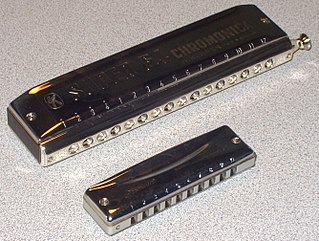
The harmonica, also known as a French harp or mouth organ, is a free reed wind instrument used worldwide in many musical genres, notably in blues, American folk music, classical music, jazz, country, and rock. The many types of harmonica include diatonic, chromatic, tremolo, octave, orchestral, and bass versions. A harmonica is played by using the mouth to direct air into or out of one holes along a mouthpiece. Behind each hole is a chamber containing at least one reed. The most common is the diatonic Richter-tuned with ten air passages and twenty reeds, often called the blues harp. A harmonica reed is a flat, elongated spring typically made of brass, stainless steel, or bronze, which is secured at one end over a slot that serves as an airway. When the free end is made to vibrate by the player's air, it alternately blocks and unblocks the airway to produce sound.
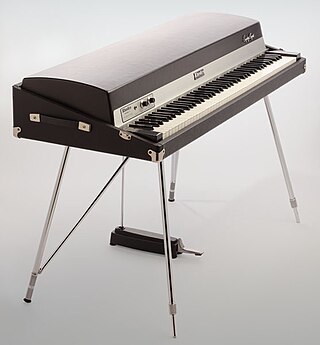
The Rhodes piano is an electric piano invented by Harold Rhodes, which became popular in the 1970s. Like a conventional piano, the Rhodes generates sound with keys and hammers, but instead of strings, the hammers strike thin metal tines, which vibrate next to an electromagnetic pickup. The signal is then sent through a cable to an external keyboard amplifier and speaker.
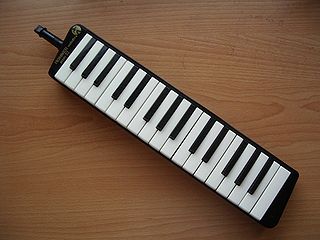
The melodica is a handheld free-reed instrument similar to a pump organ or harmonica. It features a musical keyboard on top, and is played by blowing air through a mouthpiece that fits into a hole in the side of the instrument. The keyboard usually covers two or three octaves. Melodicas are small, lightweight, and portable, and many are designed for children to play. They are popular in music education programs, especially in Asia. The modern form of the instrument was invented by Hohner in the late 1950s, though similar instruments have been known in Italy since the 19th century.

An electric piano is a musical instrument that has a piano-style musical keyboard, where sound is produced by means of mechanical hammers striking metal strings or reeds or wire tines, which leads to vibrations which are then converted into electrical signals by pickups. The pickups are connected to an instrument amplifier and loudspeaker to reinforce the sound sufficiently for the performer and audience to hear. Unlike a synthesizer, the electric piano is not an electronic instrument. Instead, it is an electro-mechanical instrument. Some early electric pianos used lengths of wire to produce the tone, like a traditional piano. Smaller electric pianos used short slivers of steel to produce the tone. The earliest electric pianos were invented in the late 1920s; the 1929 Neo-Bechstein electric grand piano was among the first. Probably the earliest stringless model was Lloyd Loar's Vivi-Tone Clavier. A few other noteworthy producers of electric pianos include Baldwin Piano and Organ Company, and the Wurlitzer Company.
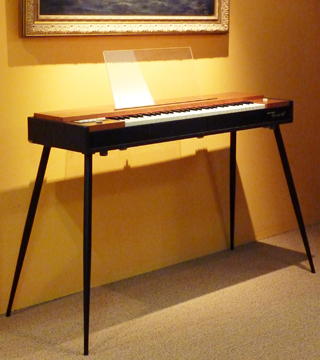
The Clavinet is an electrically amplified clavichord invented by Ernst Zacharias and manufactured by the Hohner company of Trossingen, West Germany, from 1964 to 1982. The instrument produces sounds with rubber pads, each matching one of the keys and responding to a keystroke by striking a given point on a tensioned string, and was designed to resemble the Renaissance-era clavichord.

A mouth organ is any free reed aerophone with one or more air chambers fitted with a free reed. Though it spans many traditions, it is played universally the same way by the musician placing their lips over a chamber or holes in the instrument, and blowing or sucking air to create a sound. Many of the chambers can be played together or each individually.
The Ensoniq Mirage is one of the earliest affordable sampler-synths, introduced in 1984 as Ensoniq's first product. Introduced at a list price of $1,695 with features previously only found on more expensive samplers like the Fairlight CMI, the Mirage sold nearly 8,000 units in its first year - more than the combined unit sales of all other samplers at that time.
Farfisa is a manufacturer of electronics based in Osimo, Italy, founded in 1946. The company manufactured a series of compact electronic organs in the 1960s and 1970s, including the Compact, FAST, Professional and VIP ranges, and later, a series of other keyboard instruments. They were used by a number of popular musicians including Sam the Sham, Country Joe and the Fish, Pink Floyd, Sly Stone, Blondie, and the B-52s.
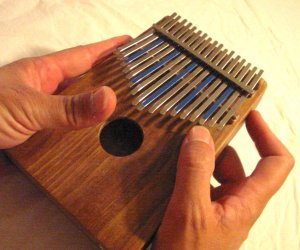
A lamellophone is a member of the family of musical instruments that makes its sound by a thin vibrating plate called a lamella or tongue, which is fixed at one end and has the other end free. When the musician depresses the free end of a plate with a finger or fingernail, and then allows the finger to slip off, the released plate vibrates. An instrument may have a single tongue or a series of multiple tongues.

The Hohner Pianet is a type of electro-mechanical piano built by the Hohner company of Trossingen, West Germany and designed by Ernst Zacharias. The Pianet was a variant of his earlier reed-based Hohner electric piano, the Cembalet, which, like the Pianet, was intended for home use. Hohner offered both keyboards in their range until 1968. The Pianet production consisted of two distinctly different mechanism groups with characteristically different sound. The first group, lasting from introduction to 1977, had ground stainless steel reeds, a pick-up using variable capacitance, and leather-faced activation pads. The second group from 1977 until the end of production used rolled spring-steel reeds, electro-magnetic pick-ups, and moulded silicone rubber activation pads.

Hohner Musikinstrumente GmbH & Co. KG is a German manufacturer of musical instruments, founded in 1857 by Matthias Hohner (1833–1902). The roots of the Hohner firm are in Trossingen, Baden-Württemberg. Since its foundation, and though known for its harmonicas, Hohner has manufactured a wide range of instruments, such as kazoos, accordions, recorder flutes, melodicas, banjos, electric, acoustic, resonator and classical guitars, basses, mandolins and ukuleles.

An expression pedal is an important control found on many musical instruments including organs, electronic keyboards, and pedal steel guitar. The musician uses the pedal to control different aspects of the sound, commonly volume. Separate expression pedals can often be added to a guitar amplifier or effects unit and used to control many different aspects of the tone.

The Wurlitzer electronic piano is an electric piano manufactured and marketed by Wurlitzer from 1954 to 1983. Sound is generated by striking a metal reed with a hammer, which induces an electric current in a pickup. It is conceptually similar to the Rhodes piano, though the sound is different.

The Vox Continental is a transistorised combo organ that was manufactured between 1962 and 1971 by the British musical equipment manufacturer Vox. It was designed for touring musicians and as an alternative to the heavy Hammond organ. It supports drawbars in a similar manner to the Hammond, and has distinctive reverse-coloured keys. The sound is generated by a series of oscillators, using a frequency divider to span multiple octaves.

The Gibson G-101 is a transistorised combo organ, manufactured in the late 1960s by the Lowrey Organ Company for Gibson.

The Guitaret is an electric lamellophone made by Hohner and invented by Ernst Zacharias, in 1963. Zacharias also invented similar instruments like the Pianet, Cembalet and the Clavinet.

The Hohner Multimonica featured a combination of a fan-blown reed organ and a monophonic sawtooth wave analog synthesizer. Produced by the German Hohner GmbH in the 1940s and 1950s, it preceded even the more famous Selmer Clavioline. Its circuitry was designed by the German engineer Harald Bode.
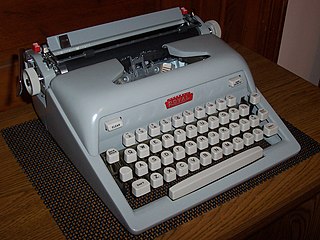
The Royal Futura is a portable, manual typewriter that was produced and sold from 1958 to 1962, by the Royal Typewriter Company division of Royal McBee Corporation. In appearance, features, and pricing, the introduction of the Futura marked a new direction in the production of Royal portable typewriters. Sales were supported by an aggressive print advertising campaign directed at students, and the Futura itself was heavily discounted towards the end of its run. The radical new design eventually found its way onto other Royal models throughout the early and mid-1960s, and the name "Futura" would appear on another model later in decade.

A digital accordion is an electronic musical instrument that uses the control features of a traditional accordion to trigger a digital sound module that produces synthesized or digitally sampled accordion sounds or, in most instruments, a range of non-accordion sounds, such as orchestral instruments, pipe organ, piano, guitar, and so on. Digital accordions typically encode and transmit key presses and other input as Musical Instrument Digital Interface (MIDI) messages. Most digital accordions need to be plugged into a keyboard amplifier or PA system to hear their sounds.

The Lambretta Model D was a scooter produced by Lambretta as a direct replacement for the Model C. The Model D was the first Innocenti scooter to be manufactured outside of Italy as the licence was sold in Europe, Asia and South America.


















